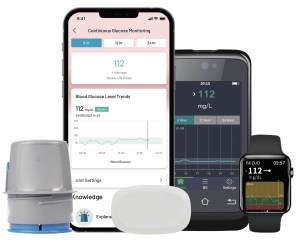
Optimising Diabetes Management by Mastering the CGM
Continuous Glucose Monitors (CGMs) are game-changers for diabetes management, providing real-time glucose data and trends that empower users to take proactive control of their health. This constant stream of information allows users to understand how their blood sugar levels respond to various factors such as diet, exercise, and medication. By seeing these patterns, users can make more informed decisions about when to eat, how much insulin to administer, and when to adjust their activity levels. This helps in preventing hyperglycemia and hypoglycemia, leading to more stable and healthier glucose levels.
With some practical know-how, you can get even more out of your CGM to optimise your diabetes management. Here are key tips and strategies to ensure your CGM works optimally for you.
Enhancing Accuracy
Calibration can greatly enhance CGM accuracy. When calibrating, always wash your hands before doing a fingerstick. If washing is not feasible, wipe away the first drop of blood and use the second. This practice helps prevent inaccurate blood glucose (BG) readings due to dirty hands, which can lead to poor CGM calibration.
When CGM readings and fingerstick values differ significantly, recheck the BG meter reading after washing your hands. Often, the CGM reading is accurate, and the initial fingerstick reading is falsely high due to unclean hands. This strategy can prevent insulin overdoses.
Avoid calibrating CGM when glucose levels are low or rapidly changing, as this can reduce accuracy. Ideal times for calibration are when glucose is stable, such as in the morning or right before bed.
CGMs tend to be less accurate on the first day, particularly after sensor insertion. Approach the first day with patience and caution, especially when dosing insulin. Accuracy usually improves as the sensor is worn longer, although this varies according to individual and device. Some users can wear their CGM sensors for up to three weeks, while others may only get 7-10 days.
Managing Alarms and Trends
Consider CGM values and alarms as a tool for better diabetes management rather than a critique of your control. This perspective can reduce unneeded and unnecessary frustration. Start with conservative alarm thresholds (e.g., 70 mg/dl for lows and 250 mg/dl for highs) and adjust them gradually to reduce annoyance. Personal preferences will vary; if your alarms are set at 80 mg/dl and 150 mg/dl, your CGM will allow you to catch highs and lows quickly, though it will result in more frequent alarms.
Avoid aggressive insulin dosing in response to high alarms, especially for those using insulin pumps. Always consider “insulin on board” or “active insulin” before taking additional insulin. The term “rage bolus,” coined by diabetes blogger Kerri Sparling, highlights the tendency to overreact to high glucose readings. Remember, insulin works slowly, especially after meals. Adjust doses based on actual needs rather than immediate CGM readings.
 Use caution with CGM hypoglycemia lag time before overeating correction carbs. After treating low glucose (e.g., with glucose tabs), if the CGM still shows low glucose, confirm with a BG meter before consuming more carbs. Often, the BG has recovered, but the CGM hasn’t yet shown the change.
Use caution with CGM hypoglycemia lag time before overeating correction carbs. After treating low glucose (e.g., with glucose tabs), if the CGM still shows low glucose, confirm with a BG meter before consuming more carbs. Often, the BG has recovered, but the CGM hasn’t yet shown the change.
Pay attention to trend arrows for adjusting insulin doses. Rising arrows indicate increasing glucose levels, possibly requiring more insulin, while falling arrows suggest decreasing levels, possibly requiring less insulin. Trend arrows can also help prevent hypoglycemia by prompting preemptive action when glucose levels are trending down.
Dealing with Adhesive Issues and Medications
Using Continuous Glucose Monitoring (CGM) systems optimally requires ensuring that the sensors stay securely attached and don’t cause irritation. Proper adhesion is critical for accurate readings and consistent monitoring. When the sensor adhesive starts peeling off, using products like Simpatch or Durapore tape can keep the sensor in place, preventing any interruptions in glucose monitoring. Simpatches are particularly convenient as they are pre-cut with a hole for the transmitter, ensuring a secure fit without obstructing the sensor’s functionality.
Adhesive allergies can be another barrier to effective CGM use. By spraying Flonase on the skin before inserting the sensor or using a Band-Aid Tough Pad as a barrier, you can mitigate allergic reactions and maintain the sensor’s placement. Addressing these issues directly impacts the accuracy and reliability of CGM readings, which is crucial for effective diabetes management.
Experiment with different wear locations for your sensor to find what works best for you. Many users find the back of the arm or the abdomen to provide better accuracy, while the buttocks or legs might not be as effective. The back of the arm and the abdomen are preferred CGM sites due to their stable placement, consistent blood flow, and reduced interference from movement and pressure. In contrast, the buttocks and legs are less effective because of variable blood flow, higher movement, and difficulty in maintaining sensor position.
Last but not least, be cautious with acetaminophen/paracetamol-containing products (e.g., Tylenol), as they can cause false high readings for certain devices, such as Medtronic CGMs and Dexcom’s G4/G5. If using one of these devices, ignore sensor glucose values for 8-10 hours after taking these products.
Optimising your CGM experience involves a blend of accurate calibration, strategic alarm settings, and mindful responses to readings and trends. These tips can significantly enhance the accuracy and reliability of your CGM, reducing frustration and improving diabetes management. For a more reliable and user-friendly CGM experience, consider exploring BUZUD’s CGMS, designed to offer precise readings and comprehensive support for your diabetes care journey.
Photo by Elena Leya on Unsplash
DISCLAIMER
All information presented herein serves as a general guideline, and is not intended as dispensing any medical advice(s). User(s) should consult their doctor to seek further clarification for any doubt. It is recommended to refer to this guide with sole discretion, thereby we shall not be held responsible for any part of the information as presented.
REimagined Healthcare with BUZUD Care Experience at:
585 North Bridge Road, #01-02 Raffles Hospital, Singapore 188770
Call: +65 6518 9959 or Email: customercare@BUZUD.com
No Comments
Leave a Reply
You must be logged in to post a comment.
